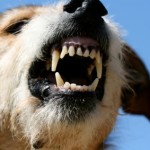
When we discuss dog aggression, the picture of growling and snarling dogs usually comes to mind; more and more breeds are being labeled, feared and believed to be “aggressive.” Our tolerant society is becoming more prejudiced of these dogs everyday.
While pet owners go through puppy after puppy trying to find the perfect breed, humane societies and rescues are saturated with the aggressive and out of control rejects.
My definition of dog aggression is: Any behavior that cannot be easily controlled.
As a long time breeder, trainer, rescue/rehabilitator and exhibitor, these are my thoughts.
If your dog:
- Aggressively chased the neighbor’s cat, but quit when you said “Leave It?”
- Greeted your guests aggressively, jumping all over them and demanding attention, but stopped when you said “Settle?”
- Aggressively ran away from you, but would come back when you said “Here?”
- Played aggressively with your children, but would lessen his intensity level when you said “Easy?”
- Barked aggressively when there was a strange noise or someone was at the door, but would quit when you said, “Good boy, that’s enough?”
Would you still consider these acts of aggression as negative?
Somehow, we have forgotten that dog aggression is actually desirable and useful. It was the ability to channel and control aggression that first attracted early man to developing a relationship with the wolf, our domestic dogs’ ancestor.
Wolves lived as contributing members of a society or pack. There was one leader and there were no equals. The more capable and responsible an individual was, the higher his ranking in the pack. The more responsibilities the more privilege he had. If a member did not contribute, he was not valued.
Supplying the food, fun, attention, comfort and safety let his members know that their leader was powerful, trustworthy, strong and caring. By also controlling these values, the leader established that he was in charge and to be respected.
The pack was not a democracy. Loyalty, respect and compliance of the members meant security, confidence and harmony in the pack. Each member was also free to challenge the leader but it was a very serious offense. The strongest and smartest would win the struggle and be the leader of the pack.
As descendants of wolves, it stands to reason that our dogs, big and small still possess the same basic values. Selective breeding has allowed us to develop predictable priorities, control size, coat and looks. Appearance aside, because dogs come from that one common ancestor, the basic values, as well as the desire and ability to use aggression have never changed.
Wolves survived because of their ability and willingness to be aggressive. So, with this said I ask you, is it aggression that is really the problem with our modern day dogs?
I believe aggression should not be feared. Instead, we must learn to channel and control aggression. Then, through clear communication, appropriate training and proper conditioning, we are able to shape the dog’s instincts, abilities as well as his aggression, add some commands and make them useful.
